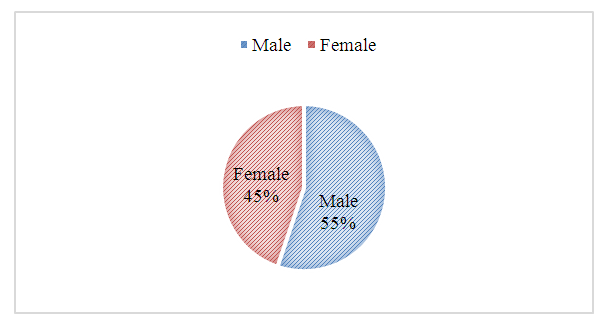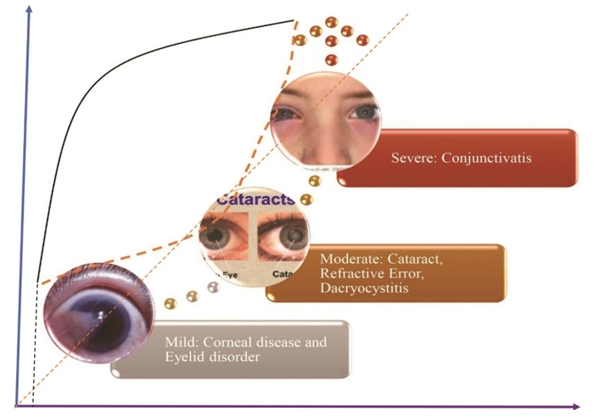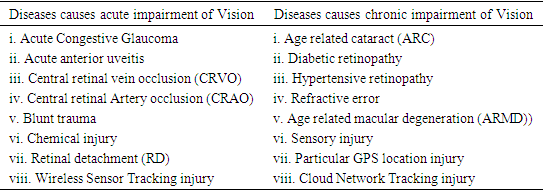-
Paper Information
- Previous Paper
- Paper Submission
-
Journal Information
- About This Journal
- Editorial Board
- Current Issue
- Archive
- Author Guidelines
- Contact Us
International Journal of Optics and Applications
p-ISSN: 2168-5053 e-ISSN: 2168-5061
2023; 9(1): 22-30
doi:10.5923/j.optics.20230901.02
Received: Apr. 16, 2023; Accepted: Jun. 12, 2023; Published: Jul. 12, 2023

Common Disease Profiles of Outpatients in Ophthalmology Department of Tertiary Care Hospital
Mohammed Selim Reza1, Md Rahimullah Miah2, Farhana Tasnim Chowdhury1, Md. Abul Khaer Chowdhury3
1Department of Ophthalmology, North East Medical College Hospital, Affiliated to Sylhet Medical University, Sylhet, Bangladesh
2Department of IT in Health, North East Medical College Hospital, Affiliated to Sylhet Medical University, Sylhet, Bangladesh
3Department of Pharmacology, North East Medical College Hospital, Affiliated with Sylhet Medical University, Sylhet, Bangladesh and MPH Awardee from Department of Pharmacology & Therapeutics of Chittagong Medical College, Affiliated to Chittagong Medical University, Chittagong, Bangladesh
Correspondence to: Mohammed Selim Reza, Department of Ophthalmology, North East Medical College Hospital, Affiliated to Sylhet Medical University, Sylhet, Bangladesh.
| Email: |  |
Copyright © 2023 The Author(s). Published by Scientific & Academic Publishing.
This work is licensed under the Creative Commons Attribution International License (CC BY).
http://creativecommons.org/licenses/by/4.0/

Eye is a very sensitive organ, which expresses the most visual perception of the body. With these eyes one can know the colorful world, see the beautiful sight, enjoy the beautiful taste. Eyes react to visible light and help people see things and keep their balance. These eyes are sometimes bright red, sometimes yellow, various problems occur including inflammation. Eye disease related primary data were collected from the Department of Ophthalmology at North East Medical College Hospital, Bangladesh and secondary data were obtained from miscellaneous sources. The study showed as 55% male and female 45% out of 2292 patients. The study showed the profiles of eye common diseases on Cataract, Dacryocystitis, Refractive Error, Conjunctivitis, Corneal disease and Eyelid Disorder. The outpatients on Conjunctivitis were 24% as the highest, where 6% was minimum on eyelid disorder. The study represents for future research trajectory with alternative methodological approach linking with National Policy and Sustainable Development Goals 2030.
Keywords: Eye disease, Outpatients, Tertiary, Inflammation, Policy
Cite this paper: Mohammed Selim Reza, Md Rahimullah Miah, Farhana Tasnim Chowdhury, Md. Abul Khaer Chowdhury, Common Disease Profiles of Outpatients in Ophthalmology Department of Tertiary Care Hospital, International Journal of Optics and Applications, Vol. 9 No. 1, 2023, pp. 22-30. doi: 10.5923/j.optics.20230901.02.
Article Outline
1. Introduction
- The human eye is an important sense organ, which is part of the sensory nervous system. Eyes react to visible light and help people see things and keep their balance. Eye gestures express many languages, signs, signals and states of mind. In humans, these eyes allow the use of visual information for various purposes, including maintaining circadian rhythms. But this eye suddenly becomes sick, it is known/unknown to many people. It is very difficult to walk in the world without eyes. The eye is a living optical device, connected to the brain by the optic nerve. The shape of the eye is roughly spherical, with the outer layers being the sclera and the inner layers being the pigmented choroid. The optic axis of the eye blocks or controls stray light. Hence it is said that the eye is the most complex sensory organ in the body, powered by the strongest and fastest muscles in the body. A healthy eye can detect four million active segments and more than 10 million colors [1]. Capable of processing and delivering 1500 pieces of information to the brain per minute, the human eye captures human life like a video camera and monitors video like a CCTV [2]. With the advancement of technology, the symptoms of various diseases are revealed through human eyes and the symptoms can be detected very easily. Because it is transparent, it is much easier to perform experiments on it than on other parts of the human body. These eyes are sometimes bright red, sometimes yellow, various problems occur including inflammation. Examination of various patients in the Ophthalmology Department of North East Medical College Hospital is known. This research will show that different causes can explain different eye symptoms in different ways.
2. Materials and Methods
2.1. Study Setting and Design
- The study was conducted at the Department of Ophthalmology (DO), North East Medical College Hospital in Sylhet, Bangladesh, which is the largest tertiary care private hospital in Sylhet region (Figure 1). The study is a retrospective descriptive study of medical record administrative data of all adult cases that presented to the health record in a one-year period.
 | Figure 1. Study Area of North East Medical College Hospital in Sylhet District, Bangladesh |
2.2. Sample
- The study population included adult patients defined as age-graded patients presenting to the DO between June 2021 and July 2022. This year was chosen as resource constraints in our medical records department caused significant backlogs in the coding of DO visits. The patients were male and female including child, adult and older. The profile was included different diseases, such as: (i) Cataract, (ii) Dacryocystitis, (iii) Refractive Error, (iv) Conjunctivitis, (v) Corneal disease, (vi) Eyelid Disorder, and (vii) Other eye diseases.
2.3. Data Source
- Data for this study were provided by the Medical Records Department of NEMCH. Disease diagnoses were coded according to ICD-9-CM, International Classification of Diseases, Ninth Revision, and clinical variables. For admitted outpatients, the principal diagnosis is the condition that initially accounted for the patient's hospitalization for care. For treat-and-discharge ED visits, the principal diagnosis is the first listed condition shown in the medical record that primarily accounts for the service provided.
2.4. Statistical Analysis
- The distribution of basic socio-demographic characteristics (age, gender), and clinical and administrative components (ESI, and admission time) were presented in a table as frequencies and percentages. Descriptive statistics were summarized by presenting the number and percentage of treat-at-release, admissions, and all ED visits for adults by age and season.
3. Results
- The findings of the study illustrated in following categories.
3.1. Identified Eye Disease Profile at Tertiary Care Hospital
- The study identified several diseases from 2292 patients. The diseases were Cataract, Dacryocystitis, Refractive error, Conjunctivitis, Corneal disease, Eyelid disorder and other diseases, which as shown in Table 1. The patients of Conjunctivitis were the highest and Eyelid disorder is the lowest patient categories at the Department of Ophthalmology from July 2021 to June 2022.
|
3.2. Sex Distribution
- The study distributed about 55% of male and 45% female patients at the department of Ophthalmology, North East Medical College Hospital, which as shown in Figure 2.
 | Figure 2. Patients distribution in sex category |
 | Figure 3. Patient’s distribution in child and adult category |
3.3. Common Disease Status
- The study showed Different types of common disease status in OPD of Ophthalmology Department of NEMCH, which as shown in Figure 4. The study identified about 24% of Conjunctival disease, which was the highest rank in this OPD, where 6% of eyelid disorder in lowest.
 | Figure 4. Common disease status in OPD of Ophthalmology Department of NEMCH |
3.4. Eye Disease Common Presentation
- The study illustrated common presentation of eye disease with different values in Figure 5. The highest values presented on dimness of vision and the lowest value in eye ache.
 | Figure 5. Common Presentation of Eye diseases |
3.5. Monthly Distribution
- The study showed the monthly distribution of common disease in OPD of Ophthalmology Department of NEMCH, which as shown in Figure 6. The study revealed that 240 of outpatients in March, 2022 was highest and 110 lowest in December, 2021.
 | Figure 6. Month wise patients’ distribution at the Department of Ophthalmology |
3.6. Top Five Disease Status
- The study showed the Top-Five disease status in OPD of Ophthalmology Department of NEMCH, which as shown in Figure 7. The study also showed that conjunctivitis was top-most, refractive error top-second, and corneal disease top-lowest.
 | Figure 7. Top-five disease status at the department of Ophthalmology |
3.7. Impairment of Vision
- The study compared the patients with disease causes of acute impairment of vision and chronic impairment of vision at the department of Ophthalmology, NEMCH, which as shown in Table 2.
|
3.8. Disease Severity
- The study showed that the patients of conjunctivitis were affected severely among the outpatients at the department of ophthalmology, NEMCH, which as shown curve in Figure 8.
 | Figure 8. Eye disease mild, moderate and severity at the study in NEMCH |
3.9. Inference
- The study showed in inference the conjunctivitis is severe in the study area.
4. Discussion
- The study found that the number of patients with conjunctivitis was high among eye diseases, as the disease is known to be a seasonal disease in the area and many patients were not aware of the effects of eye disease. Again, North East Medical College Hospital (NEMCH) is close to them and satisfied with the medical services.
4.1. Impact of Common Diseases in Outpatients
- Studies show that sometimes patients with serious eye disorders like conjunctivitis, glaucoma, refractive error, cataract, dacryocystitis with diabetes, breathing problems or high blood pressure are referred to Sylhet MAG Osmani Medical College Hospital for more detailed diagnosis, testing with state-of-the-art technology and free medical assistance. When NEMCH does not have an ophthalmologist in time to provide these special supports, such initiatives are taken quickly by the healthcare service, so that no negligence is observed in the service, and the patient's relatives are satisfied. But this is rare, as NEMCH assists patients 24/7 hours. In special cases, antibiotic eye drops are used to clear the infection or disorder. Acute irritant conjunctivitis clears as it resolves. Acute allergic conjunctivitis is usually treated with anti-allergy medications including antihistamines. The most essential treatment for acute dacryocystitis is to administer several oral antibiotics for 5-7 days to rapidly eradicate the underlying bacterial infection, such as (a) cephalexin, (b) ciprofloxacin, and (c) amoxicillin-clavulanate. Again, if the disease is aggravated by tracking the sensor technology, it is called to adhere to the EDRAST (Eye Disease Recovery through Advanced Sensor Technology) principles [4,10]. Surgery is an alternative treatment pathway to stop recurrence [35]. Eye doctors routinely correct refractive errors with glasses or contact lenses. In some patients, eye doctors also correct the refractive error through surgery. Research shows that glasses are the easiest, most reliable and safest way to correct refractive errors [33].Studies show that individuals can suffer from eye diseases at any given GPS location due to various human-caused risks [3]. Research shows that through eye gestures, the language of the human mind can be understood, feelings can be expressed - so that many thoughts and consciousness are born between each other. A wink speaks more than a thousand words and conveys a thoughtful image. These eyes not only speak but also tell the symptoms of many complex diseases. Thus, the eye is a very sensitive organ, which expresses the most visual perception of the body. With these eyes one can know the colourful world, see the beautiful sight, enjoy the beautiful taste and see the nature from one country to another. The whole body has a biological connection with this eye. Apart from vision, this organ has a special effect on brain function. In today's world, people are facing various problems due to eye diseases such as age-related conjunctivitis, macular degeneration, dacryocystitis, refractive errors, cataracts, diabetic retinopathy, corneal diseases, eyelid disorders and glaucoma. Other common eye disorders include amblyopia, sensitive chronic thyroid eye disease, acute uveitis, and strabismus. The scientists and ophthalmologists still can’t point out the root causes of visual impairment, although there are several reasons for impairment of vision including heredity causes, structural, prenatal, birth injury, eye disease, underweight baby, unwanted accident and misuse of advanced wireless sensor technology [3].
4.2. Direct Effective Event on Conjunctivitis
- From September 23, 2022 to October 14, 2022, an outbreak of conjunctivitis, or eye disease, occurred among approximately 800 inmates at the Dhaka Central Jail in Keraniganj, Bangladesh [32]. About 400 prisoners have recovered from the disease. According to prison sources, there are currently around 9,000 prisoners in this prison. For 15 to 20 days, many prisoners including prison officials, prison guards have been infected with this disease. To avoid the outbreak, the doctor in charge of the prison advised the infected inmates not to eat shrimp, hilsa and beef. Apart from this, the jail authorities have also taken precautionary measures in bringing the prisoners from the jail to the court. Research shows that cybercriminals spread conjunctivitis by tracking wireless sensors over the eyes of inmates [4], particularly prison officers, prison guards, and those with fixed GPS location and open eyes, but no network isolators. So, all or a select few livings in the area were affected by primary cystic disease, especially conjunctivitis. No matter how many restrictions are placed on certain foods, the disease will continue to spread – unless tracked to specific GPS locations with wireless sensors in a cloud network [4]. So, conjunctivitis with food has no special effect, abuse of wireless sensor network causes sudden spread of various diseases, i.e., outbreak of conjunctivitis.
4.3. Co-morbidity and Sensor Technology
- Occasionally, both adult and pediatric patients suffer with sudden onset of dacryocystitis and Kawasaki disease, much to the dismay of the patient's relatives. Dacryocystitis is usually secondary to nasolacrimal duct obstruction [34]. Untreated dacryocystitis can lead to various complications such as corneal ulcer, lacrimal abscess, meningitis, brain abscess, cavernous sinus thrombosis, orbital cellulitis, severe sinusitis, permanent vision loss and even sudden death. Early diagnosis according to risk factors, installation of a wireless sensor network control unit or network isolator in the patient room, prompt treatment and close follow-up are beneficial for the patient. Kawasaki disease is a sensorineural disease, a sudden onset of acute illness in infants and young children [32]. The main symptoms of this disease are sudden onset of fever, rash and glandular swelling associated with vasculitis affecting the coronary arteries and resulting in severe cardiac arrest. Occasionally, children develop conjunctivitis with Kawasaki disease. Due to wireless sensor tracking, patients suffer from various physical complications including cardiac arrest, diabetes, chronic kidney disease, skin diseases, breathing difficulties, hip pain, paralysis, brain cancer, covid-19, glaucoma, liver cirrhosis, Kawasaki disease and lung infections [4].
4.4. Myths about Eye Disease
- In various human societies of the world, there are still lies about eye diseases, which lead to worry about eye diseases. Some of these myths are highlighted. If the eye sight is 6/6, i.e., reading up to the last line of the eye chart, the person's eyes are fine - this is wrong. Due to this the person may have poor eyesight, side vision, poor color vision and free eye glaucoma. The idea that overuse causes eye damage is wrong, because - no matter how often and how long a person sees in sufficient light - eyes will never deteriorate. But care should be taken to do everything that can be done to keep the eyes healthy. Many people think that wearing glasses with too much power will make the eyes worse, but this idea is wrong. Because high power glasses never physically change the inside of the eye. Many people think that wearing glasses at a young age will make your eyes worse, but this idea is wrong. Because, people who have some kind of refractive error, or have amblyopia or cataracts are given glasses. So, whether the age is young or old - glasses are given according to the doctor's advice. Besides, eye diseases are on the rise due to the spread of the coronavirus – this is also a misconception, as the spread of the disease varies from region to region [3].
4.5. Challenges
- Tracking with advanced wireless sensor technology inadvertently exposes people with eye disease to COVID-19 [3,4,7,8,9,10,11,12,13,14], ARDS [20,40], Cardiac arrest [18], stomach cancer [30], Diabetes [15,16], Dengue [31], Numbness [17], Digital dermal disease [28,29], Acute Lymphoblastic Leukemia [36], Oral Cancer [37], CASSID [9,21], environmental diseases through man-made flash flood [26,27] and technological heatwaves [19;21]. This technology is a challenge for all patients due to the lack of safety measures in national, regional and global contexts due to climate change on environmental health [23,24]. Artificial intelligence to reduce eye health disparities, but too expensive in rural and remote areas [5,25]. Self-regulation issues related to telemedicine support for child development are at risk due to lack of secure network availability [6,22,39]. Moreover, Human behavior is the root cause of all infections and its practice is the dynamic solution to disease management [38].
5. Conclusions
- Finally, the outpatients with conjunctivitis are severe at the Department of Ophthalmology of North East Medical College Hospital, Sylhet, Bangladesh. Other diseases are moderate and mild in the study area. Health administration and policy makers are still not fully aware of this phenomenon. But the impact of this severity is increasing day by day, if no remedy is taken, it will spread in the form of an epidemic and many people will be harmed. As a result, the Sustainable Development Goals 2030 are unlikely to be achieved.
Declaration
- FundingThis research work has no financial support from any doners. So, the funders had no role in the design of the research, in data collection, analyses or final interpretation of data, in the writings of the manuscript, or in the decision to publish the findings.Data AvailabilityThe data being used to support the findings of this research work are available from the corresponding author upon request. Competing InterestsThe authors declare no potential conflict of interests in this research work.
ACKNOWLEDGEMENTS
- The authors acknowledged the authority of North East Medical College Hospital (NEMCH), affiliated with Sylhet Medical University at Sylhet in Bangladesh for kind support.
 Abstract
Abstract Reference
Reference Full-Text PDF
Full-Text PDF Full-text HTML
Full-text HTML
